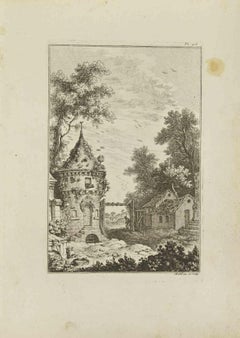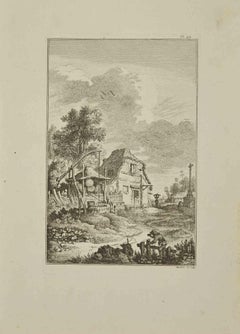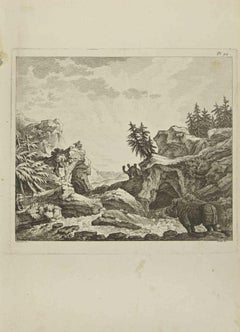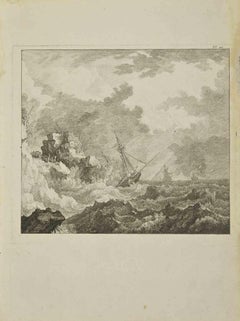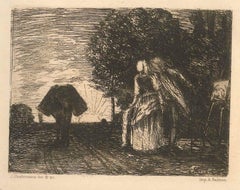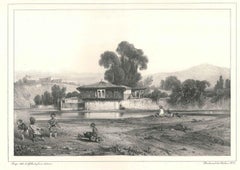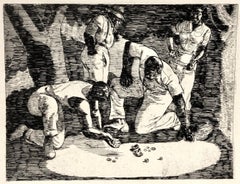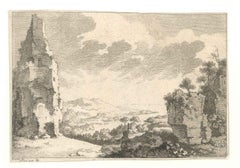Pierre Quentin Chedel Art
to
5
4
4
4
4
2
1
1
Landscape - Etching by Pierre Quentin Chedel - 1755
By Pierre Quentin Chedel
Located in Roma, IT
Landscape is an etching realized by Pierre Quentin Chedel in 1755.
Good conditions.
Signed on Plate.
The artwork is depicted through confident strokes.
The etching was realized f...
Category
1750s Pierre Quentin Chedel Art
Materials
Etching
Landscape - Etching by Pierre Quentin Chedel - 1755
By Pierre Quentin Chedel
Located in Roma, IT
Landscape is an etching realized by Pierre Quentin Chedel in 1755.
Good conditions.
Signed on Plate.
The artwork is depicted through confident strokes.
The etching was realized f...
Category
1750s Pierre Quentin Chedel Art
Materials
Etching
Landscape - Etching by Pierre Quentin Chedel - 1755
By Pierre Quentin Chedel
Located in Roma, IT
Landscape is an etching realized by Pierre Quentin Chedel in 1755.
Good conditions.
Signed on Plate.
The artwork is depicted through confident strokes.
The etching was realized f...
Category
1750s Pierre Quentin Chedel Art
Materials
Etching
The Ocean - Etching by Pierre Quentin Chedel - 1755
By Pierre Quentin Chedel
Located in Roma, IT
The Ocean is an etching realized by Pierre Quentin Chedel in 1755.
Good conditions.
The artwork is depicted through confident strokes.
The etching was realized for the anatomy stu...
Category
1750s Modern Pierre Quentin Chedel Art
Materials
Etching
L'Heure du Berger - Original Etching by J. Desbrosses
By Pierre Quentin Chedel
Located in Roma, IT
L'Heure du Berger is an original artwork realized by Jean Desbrosses in the second half of the XIX century.
Original etching on paper. Passepartout in...
Category
19th Century Pierre Quentin Chedel Art
Materials
Etching
Au Bord d'une Rivière - Original Lithograph by A. Decamps
By Pierre Quentin Chedel
Located in Roma, IT
Au Bord d'une Rivière is an original artwork realized by Alexandre Decamps in 1831.
Original lithograph on paper.
Very good conditions.
Original artwork representing a river with ...
Category
1830s Pierre Quentin Chedel Art
Materials
Lithograph
Related Items
"Grande Irène Vignier" Signed Etching, State Proof, Young Girl, Duthuit 19
By Henri Matisse
Located in Yardley, PA
A superb example of the Matisse’s mastery of line, restraint, and psychological nuance. The sitter, a young girl rendered with the most economical of strokes, emerges from the page w...
Category
1910s Modern Pierre Quentin Chedel Art
Materials
Etching
$12,000
H 25.5 in W 21.25 in D 3 in
Irving Guyer, Roll Them Bones, Depression-era African-American men at craps
By Irving Guyer
Located in New York, NY
An American Depression-Era subject of African-American men playing craps by Irving Guyer.. (Craps is a game of chance that required neither skill nor strategy. The object is to predi...
Category
1930s Ashcan School Pierre Quentin Chedel Art
Materials
Etching
Study for a Monument in the Heroic/Erotic/Academic/Comic Style Claes Oldenburg
By Claes Oldenburg
Located in New York, NY
This sensuous and playful scene is characteristic of Oldenburg’s printmaking ouevre: a veritable heap of women displaying various expressions of ecstasy and repose. The loose sketches were drawn directly onto the plate by the artist, a master draftsman whose erotic etchings are largely unknown. The composition is based on the drawing: Clinical Study, Towards a Heroic-Erotic Monument in the Academic/Comic Style, 1965, ball-point pen on paper, 20 x 40 in. / 60 x 101.6 cm.
*This print was etched in six gorgeous inks, each in an edition of ten: take your pick of color!*
Oldenburg had an interest in imaginary monuments: he famously conceptualized works such as “Ball”, an unbuilt monument conceived of in 1967 which imagined two ballcocks – the round mechanism in a toilet tank...
Category
1970s Modern Pierre Quentin Chedel Art
Materials
Etching
$1,125
H 37.75 in W 41.75 in
Birds - XXI century, Figurative print, Black and white, Animals
By Anna Mikke
Located in Warsaw, PL
Limited edition, 8/10. ANNA MIKKE (born in 1950) She graduated from the Academy of Fine Arts in Łódź in 1975. After graduation, she was engaged in graphic design, including designing...
Category
2010s Other Art Style Pierre Quentin Chedel Art
Materials
Paper, Etching
$180
H 4.73 in W 10.04 in
Vintage David Hockney Poster Miami New World Festival of Arts 1982 palm trees
By David Hockney
Located in New York, NY
This vintage David Hockney poster features whimsical imagery and rich, bright color. Palm trees, boats in the ocean, a cafe, and a bodega with an elaborate iron-wrought balcony sit a...
Category
1980s Realist Pierre Quentin Chedel Art
Materials
Lithograph
Modernist FOLK ART Original Pencil Lithograph "GRAY DAY AT THE BEACH"
By Doris Lee
Located in New York, NY
Doris Lee
Lithograph
1964
Edition Size: 250
Image Size: 12 x 9.5 inches
Sheet Size: 16.75 x 13 inches
Reference: AAA 1532
Signed lower left
Condition: Good
Provenance: ASA
Doris Emrick Lee...
Category
1960s Folk Art Pierre Quentin Chedel Art
Materials
Lithograph, Archival Pigment
$1,100
H 17 in W 13 in D 1 in
Rapunzel, Rapunzel, let down your hair David Hockney Brothers Grimm Fairy Tales
By David Hockney
Located in New York, NY
From David Hockney’s celebrated Six Fairy Tales from the Brothers Grimm portfolio, an image from the story of Rapunzel, which he chose for its popularity. When illustrating the princ...
Category
1960s Modern Pierre Quentin Chedel Art
Materials
Etching, Aquatint
"Gothic Gables" New York Graphic Society 1966, Printed in Switzerland
By Lyonel Feininger
Located in Chesterfield, MI
"Gothic Gables" Poster/Print by LYONEL FEININGER (American-German, 1871-1956). The print measures approximately 20 x 27 inches and is unframed. Published by New York Graphic Society 1966. Printed in Switzerland...
Category
1960s Pierre Quentin Chedel Art
Materials
Lithograph
“Winter” from the “Four Seasons Suite” Series
By Alvar Sunol Munoz-Ramos
Located in San Francisco, CA
This embossed, numbered and signed lithograph, part of the “Four Seasons Suite,” is by Alvar Suñol Muñoz-Ramos (b. 1935), a renowned Spanish ar...
Category
1970s Modern Pierre Quentin Chedel Art
Materials
Paper, Lithograph
$1,350
H 37.25 in W 30.5 in D 2 in
Original A Wonderful Opportunity for You, United States Navy 1917 vintage poster
Located in Spokane, WA
Original WW1 poster: A Wonderful Opportunity for You. Ashore, on leave. United States Navy. A pre-war recruiting lithographic poster features an ebullient sailor going home o...
Category
1910s American Modern Pierre Quentin Chedel Art
Materials
Lithograph
$1,575
H 28.25 in W 20.75 in D 0.05 in
Manhattan View, Governor's Island (Szoke 87, 89). Aquatint & Etching SiGNED/N
By Richard Haas
Located in New York, NY
Richard Haas
Manhattan View, Governor's Island (Szoke 87, 89), 1999
Aquatint & Photo Etching in Colors on Arches Cover Paper with full margins
Pencil signed from the limited edit...
Category
1990s Contemporary Pierre Quentin Chedel Art
Materials
Etching, Aquatint
The glass mountain shattered David Hockney Fairy Tales from the Brothers Grimm
By David Hockney
Located in New York, NY
This etching from David Hockney’s celebrated Six Fairy Tales from the Brothers Grimm portfolio depicts the somewhat obscure story Old Rinkrank, which Hockney chose to illustrate beca...
Category
1960s Modern Pierre Quentin Chedel Art
Materials
Etching, Aquatint
Previously Available Items
Landscape with Rocks - Original Etching by P.Q. Chedel
By Pierre Quentin Chedel
Located in Roma, IT
Landscape with Rocks is an original artwork realized by Pierre Quentin Chedel in the middle of the XVIII century.
Original etching on paper after an original work of art by François...
Category
18th Century Old Masters Pierre Quentin Chedel Art
Materials
Etching
H 4.53 in W 6.7 in D 0.04 in
Pierre Quentin Chedel art for sale on 1stDibs.
Find a wide variety of authentic Pierre Quentin Chedel art available for sale on 1stDibs. You can also browse by medium to find art by Pierre Quentin Chedel in etching, lithograph and more. Much of the original work by this artist or collective was created during the 18th century and is mostly associated with the modern style. Not every interior allows for large Pierre Quentin Chedel art, so small editions measuring 8 inches across are available. Customers who are interested in this artist might also find the work of Eugene Corneau, Maxime Lalanne, and Charles Courtry. Pierre Quentin Chedel art prices can differ depending upon medium, time period and other attributes. On 1stDibs, the price for these items starts at $111 and tops out at $267, while the average work can sell for $245.
